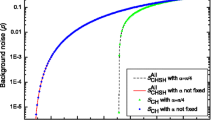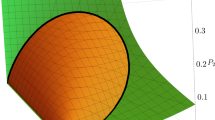Abstract
As we know, the violations of Bell inequalities reveal nonlocality. On the other hand, loopholes in any Bell tests can cause the issues in the interpretation of the above conclusion, since an apparent violation of Bell inequality may not correspond to a real violation of local realism. The detection loophole, as an important example, arises when the overall detection efficiency is not larger than a certain threshold value. With the detection loophole, the above-mentioned effect can be observed in many experiments where the partial detected events can cause apparent Bell violations, while the entire ensemble cannot violate them. However, the real violations of Bell inequalities are necessary for device independence quantum information processing tasks. So, it is crucial to investigate the critical detection efficiency for closing the detection loophole of Bell inequalities. Here, by considering some novel Bell inequalities (Mironowicz and Pawłowski in Phys Rev A 88:032319, 2013), we give the critical detection efficiency for closing the detection loophole of these Bell inequalities. Furthermore, we prove the tightness of these detection efficiency bounds. That is, if detection efficiency is not larger than the critical one, we construct local hidden variable models to reproduce these violations. To sum up, if the detection efficiency of experiment exceeds the critical one derived here, the detection loophole is eliminated.


Similar content being viewed by others
Explore related subjects
Discover the latest articles and news from researchers in related subjects, suggested using machine learning.References
Einstein, A., Podolsky, B., Rosen, N.: Can quantummechanical description of physical reality be considered complete? Phys. Rev. 47(10), 777 (1935)
Bell, J.: On the Einstein–Podolsy–Rosen paradox. Physics 1, 195 (1964)
Brunner, N., Cavalcanti, D., Pironio, S., Scarani, V., Wehner, S.: Bell nonlocality. Rev. Mod. Phys. 86, 419 (2014)
Giustina, M., Versteegh, M.A.M., Wengerowsky, S., et al.: Significant-loophole-free test of Bell’s theorem with entangled photons. Phys. Rev. Lett. 115, 250401 (2015)
Rosenfeld, W., Burchardt, D., Garthoff, R., et al.: Event-ready bell test using entangled atoms simultaneously closing detection and locality loopholes. Phys. Rev. Lett. 119, 010402 (2017)
Garg, A., Mermin, N.D.: Detector inefficiencies in the Einstein–Podolsky–Rosen experiment. Phys. Rev. D 35, 3831 (1987)
Eberhard, P.H.: Background level and counter efficiencies required for a loophole free Einstein–Podolsky–Rosen experiment. Phys. Rev. A 47, 747–750 (1993)
Acín, A., Brunner, N., Gisin, N., Massar, S., Pironio, S., Scarani, V.: Device-independent security of quantum cryptography against collective attacks. Phys. Rev. Lett. 98, 230501 (2007)
Bardyn, C.E., Liew, T.C., Massar, S., Mckague, M., Scarani, V.: Device-independent state estimation based on Bell’s inequalities. Phys. Rev. A 80, 062327 (2009)
Acín, A., Gisin, N., Masanes, L.: From Bell’s theorem to secure quantum key distribution. Phys. Rev. Lett. 97, 120405 (2006)
Vazirani, U., Vidick, T.: Fully device-independent quantum key distribution. Phys. Rev. Lett. 113, 140501 (2014)
Pironio, S., Acín, A., Massar, S., de La Giroday, A.B., Matsukevich, D.N., Maunz, P., Olmschenk, S., Hayes, D., Luo, L., Manning, T.A., Monroe, C.: Random numbers certified by Bell’s theorem. Nature 464, 1021 (2010)
Pironio, S., Massar, S.: Security of practical private randomness generation. Phys. Rev. A 87, 012336 (2013)
Fehr, S., Gelles, R., Schaffner, C.: Security and composability of randomness expansion from Bell inequalities. Phys. Rev. A 87, 012335 (2013)
Mironowicz, P., Pawłowski, M.: Robustness of quantum-randomness expansion protocols in the presence of noise. Phys. Rev. A 88, 032319 (2013)
Li, H.-W., Yin, Z.Q., Wang, S., Qian, Y.J., Chen, W., Guo, G.C., Han, Z.F.: Randomness determines practical security of BB84 quantum key distribution. Sci. Rep. 5, 16200 (2015)
Li, D.-D., Wen, Q.Y., Wang, Y.K., Zhou, Y.Q., Gao, F.: Security of semi-device-independent random number expansion protocols. Sci. Rep. 5, 15543 (2015)
Li, D.-D., Zhou, Y.Q., Gao, F., Li, X.H., Wen, Q.Y.: Effects of measurement dependence on generalized Clauser–Horne–Shimony–Holt Bell test in the single-run and multiple-run scenarios. Phys. Rev. A 94, 012104 (2016)
Li, H.-W., Pawłowski, M., Yin, Z.Q., Guo, G.C., Han, Z.F.: Semi-device-independent randomness certification using \(n\rightarrow 1\) quantum random access codes. Phys. Rev. A 85, 052308 (2012)
Jakobi, M., Simon, C., Gisin, N., Bancal, J.D., Branciard, C., Walenta, N.: Practical private database queries based on a quantum-key-distribution protocol. Phys. Rev. A 83, 022301 (2011)
Gao, F., Liu, B., Huang, W., Wen, Q.Y.: Postprocessing of the oblivious key in quantum private query. IEEE. J. Sel. Top. Quant. 21, 6600111 (2015)
Wei, C.Y., Wang, T.Y., Gao, F.: Practical quantum private query with better performance in resisting joint-measurement attack. Phys. Rev. A 93, 042318 (2016)
Wei, C.Y., Cai, X.Q., Liu, B., Wang, T.Y., Gao, F.: A generic construction of quantum-oblivious-key-transfer-based private query with ideal database security and zero failure. IEEE Trans. Comput. 99, 2–8 (2018)
Liu, B., Gao, F., Wei, C., Wen, Q.Y.: Qkd-based quantum private query without a failure probability. Sci. China Phys. Mech. Astron. 58, 100301 (2015)
Rowe, M.A., et al.: Experimental violation of a Bell’s inequality with efficient detection. Nature 409, 791–794 (2001)
Matsukevich, D.N., Maunz, P., Moehring, D.L., Olmschenk, S., Monroe, C.: Bell inequality violation with two remote atomic qubits. Phys. Rev. Lett. 100, 150404 (2008)
Ansmann, M., et al.: Violation of Bell’s inequality in Josephson phase qubits. Nature 461, 504–506 (2009)
Hofmann, J., et al.: Heralded entanglement between widely separated atoms. Science 337, 72–75 (2012)
Giustina, M., et al.: Bell violation using entangled photons without the fair-sampling assumption. Nature 497, 227–230 (2013)
Christensen, B.G., McCusker, K.T., Altepeter, J.B., et al.: Detection-loophole-free test of quantum nonlocality, and applications. Phys. Rev. Lett. 111, 130406 (2013)
Hensen, B., Bernien, H., Dréau, A.E., et al.: Loophole-free Bell inequality violation using electron spins separated by 1.3 kilometres. Nature 526, 682 (2015)
Larsson, J.-Å.: Bell’s inequality and detector inefficiency. Phys. Rev. A 57, 3304 (1998)
Cabello, A., Larsson, J.-Å., Rodríguez, D.: Minimum detection efficiency required for a loophole-free violation of the Braunstein–Caves chained Bell inequalities. Phys. Rev. A 79, 062109 (2009)
Pütz, G., Martin, A., Gisin, N., Aktas, D., Fedrici, B., Tanzilli, S.: Quantum nonlocality with arbitrary limited detection efficiency. Phys. Rev. Lett. 116, 010401 (2016)
Xiang, Y., Wang, H.-X., Hong, F.-Y.: Detection efficiency in the loophole-free violation of Svetlichny’s inequality. Phys. Rev. A 86, 034102 (2012)
Cabello, A., Rodríguez, D., Villanueva, I.: Necessary and sufficient detection efficiency for the Mermin inequalities. Phys. Rev. Lett. 101, 120402 (2008)
Cañas, G., Barra, J.F., Gómez, E.S., Lima, G., Sciarrino, F., Cabello, A.: Detection efficiency for loophole-free Bell tests with entangled states affected by colored noise. Phys. Rev. A 87, 012113 (2013)
Massar, S., Pironio, S.: Violation of local realism versus detection efficiency. Phys. Rev. A 68, 062109 (2003)
Larsson, J.-Å., Semitecolos, J.: Strict detector-efficiency bounds for n-site Clauser–Horne inequalities. Phys. Rev. A 63, 022117 (2001)
Vértesi, T., Pironio, S., Brunner, N.: Closing the detection loophole in Bell experiments using qudits. Phys. Rev. Lett. 104, 060401 (2010)
Massar, S.: Nonlocality, closing the detection loophole, and communication complexity. Phys. Rev. A 65, 032121 (2002)
Pál, K.F., Vértesi, T.: Closing the detection loophole in tripartite Bell tests using the W state. Phys. Rev. A 92, 022103 (2015)
Pál, K.F., Vértesi, T.: Bell inequalities violated using detectors of low efficiency. Phys. Rev. A 92, 052104 (2015)
Pál, K.F., Vértesi, T., Brunner, N.: Closing the detection loophole in multipartite Bell tests using Greenberger–Horne–Zeilinger states. Phys. Rev. A 86, 062111 (2012)
Cao, Z., Peng, T.: Tight detection efficiency bounds of Bell tests in no-signaling theories. Phys. Rev. A. 94, 042126 (2016)
Acknowledgements
We appreciate the anonymous reviewers for their valuable suggestions. This work is supported by NSFC (Grant Nos. 61802033, 61671082, 61672110, 61572081, 61701553), Science and Technology Department of Hennan (No.172102210275).
Author information
Authors and Affiliations
Corresponding author
Additional information
Publisher's Note
Springer Nature remains neutral with regard to jurisdictional claims in published maps and institutional affiliations.
5. Appendix
5. Appendix
1.1 5.1 The Proof of Lemma 1
Proof
Based on Ref. [32], it is obvious that \(p(\varLambda _{A_{j}}|\varLambda _{A_{j}B_{k}})=p(\varLambda _{B_{k}}|\varLambda _{A_{j}B_{k}})=1\).
For \(j'\ne j\), \(p(\varLambda _{A_{j'}}|\varLambda _{A_{j}B_{k}})\) is given by
where we use the definition of detection efficiency of each party and Eq. (8). So, \(\eta \le p(\varLambda _{A_{j'}}|\varLambda _{B_{k}}), \eta \le p(\varLambda _{A_{j}}|\varLambda _{B_{k}})\).
Furthermore, when \(j'\ne j\) and \(k'\ne k\), \(p(\varLambda _{A_{j'}B_{k'}}|\varLambda _{A_{j}B_{k}})\) can be deduced by
where the first line holds according to the fact \(\varLambda _{A_{j'}B_{k'}}=\varLambda _{A_{j'}}\cap \varLambda _{B_{k'}}\) and \(p(x y)=p(x)+p(y)-p(x\cup y)\), the second line holds based on Eq. (46) and \(p(\varLambda _{A_{j'}}\cup \varLambda _{B_{k'}}|\varLambda _{A_{j}B_{k}})\le 1\).
Finally, we calculate \(\delta _{I_{0}}\), without loss of generality, we assume that \(j=1, k=2\),
where the forth line holds since \(p(\varLambda _{A_{1}B_{2}}|\varLambda _{A_{1}B_{2}})=1, p(\varLambda _{A_{2}B_{3}}\cup \varLambda _{A_{1}B_{2}}|\varLambda _{A_{1}B_{2}})\le 1.\) The fifth line holds based on Eq. (47). So, we get
\(\square \)
1.2 5.2 The Proof of Lemma 2
Proof
Obviously, \(\varLambda _{0}\subset \varLambda _{A_{j}B_{k}}\), so we define \(\overline{\varLambda _{0}}=\varLambda _{A_{j}B_{k}}\setminus \varLambda _{0}\), which satisfies that
Next, we have
where \(E(|A_{j}B_{k}|)=\sum _{a,b}|ab|p(a,b|j,k)\).
The first equation holds based on \(\varLambda _{A_{j}B_{k}}=\varLambda _{0}+\overline{\varLambda _{0}}\), \(E(A_{j}B_{k}\) \(|\varLambda _{A_{j}B_{k}})=p(\overline{\varLambda _{0}}|\varLambda _{A_{j}B_{k}})\) \(E(A_{j}B_{k}|\overline{\varLambda _{0}}) +p(\varLambda _{0}|\varLambda _{A_{k}B_{k}})E(A_{j}B_{k}|\varLambda _{0})\), and the first inequality holds based on \(|x+y-z|\le |x|+|y-z|\). The second inequality holds based on \(|E(xy)|\le E(|xy|)\). The last inequality holds because that \(E(|A_{j}B_{k}||\overline{\varLambda _{0}})=1\) and \(E(|A_{j}B_{k}||\varLambda _{0})=1\) due to measurement outcomes \(a,b\in \{+1,-1\}\). \(\square \)
1.3 5.3 The Proof of (31)
Proof
Based on \(\delta _{I_{1}}=\min _{(j,k)}p(\varLambda _{0}|\varLambda _{A_{j}B_{k}})\) for \(j, k \in \{1,2,3\}\), without loss of generality, we assume that \(j=1, k=2\),
where \(\varLambda _{0}=\varLambda _{A_{1}}\cap \varLambda _{A_{2}}\cap \varLambda _{A_{3}}\cap \varLambda _{B_{1}}\cap \varLambda _{B_{2}}\cap \varLambda _{B_{3}}=\varLambda _{A_{1}B_{2}}\cap \varLambda _{A_{2}B_{3}}\cap \varLambda _{A_{3}B_{1}}\), \(p(\varLambda _{A_{1}B_{2}}|\varLambda _{A_{1}B_{2}})=1\).
Furthermore, \(P(\varLambda _{0}|\varLambda _{A_{1}B_{2}})\) can be deduced by
where the second line holds because \(\varLambda _{A_{2}B_{3}}\cap \varLambda _{A_{3}B_{1}}=\varLambda _{A_{2}B_{3}}+\varLambda _{A_{3}B_{1}} -\varLambda _{A_{2}B_{3}}\cup \varLambda _{A_{3}B_{1}}\), the third line holds since \(p(\varLambda _{A_{2}B_{3}}\cup \varLambda _{A_{3}B_{1}}|\varLambda _{A_{1}B_{2}})\le 1\), and then the last inequality holds based on the relation (46).
Furthermore, \(p(\varLambda _{0}|\varLambda _{A_{j}B_{k}})\ge 5-\frac{4}{\eta }\). So, we get
\(\square \)
Rights and permissions
About this article
Cite this article
Li, DD., Gao, F., Cao, Y. et al. The critical detection efficiency for closing the detection loophole of some modified Bell inequalities. Quantum Inf Process 18, 123 (2019). https://doi.org/10.1007/s11128-019-2238-1
Received:
Accepted:
Published:
DOI: https://doi.org/10.1007/s11128-019-2238-1




